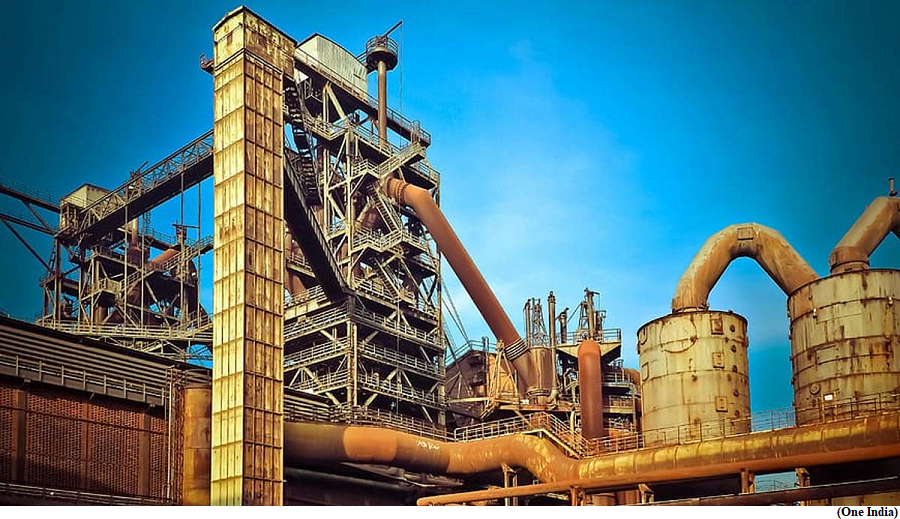India has emerged as the 2nd Largest Producer of Crude Steel in the world (GS Paper 3, Economy)

Why in news?
- Recently, the Union Minister of Steel and Civil Aviation, held a press conference on the theme 9-years of Government's "Seva, Sushasan and Gareeb kalyan" focusing on the Steel sector.
India achievements:
- India currently ranks as the World's 2nd Largest Producer of Crude Steel, surpassing Japan in 2018.
- India stands as a net exporter of steel witnessing an export of 6.72 MT of finished steel against the import of 6.02 MT in 2022-23. The country was a net importer of steel in 2014-15 with 9.32 MT imports Vis-à-vis the export of 5.59 MT.
- In the past 9 years (2014-15 to 2022-23), Steel CPSEs viz. SAIL, NMDC, MOIL, KIOCL, MSTC, and MECON, used ₹90,273.88 crores of their own resources for CAPEX and paid a dividend to the Government of India to the tune of ₹21,204.18 crores
Steel Scrap Recycling Policy:
- Six Vehicle Scrapping Centres have been opened in various cities, with three more planning to begin their operations soon.
- The End-of-life vehicles (ELVs), will be used as raw material for the production of steel and in this regard state governments as well as private sector are being on-boarded.
National Steel Policy 2017 (NSP 2017):
- With a focus on developing a “technologically advanced and globally competitive steel industry that promotes economic growth”, he highlighted the targets set by NSP 2017, which will take the steel sector to new heights.
- India has set the targets of achieving the total crude steel capacity of 300 MTPA and total crude steel demand/production of 255 MTPA by 2030-31. By 2030-31, it is also envisaged to enhance the operational capacity of crude steel production of SAIL from existing 19.51 MTPA to around 35.65 MTPA tentatively.
Productivity Linked Incentive Scheme (PLI):
- So far 57 MoUs involving 27 companies have been signed under the PLI Scheme for domestic production of specialty steel. This will attract a committed investment of around ₹30,000 crore with a downstream capacity addition of 24.7 million tonne and an employment generation potential of 55000.
- ‘Brand India’ labeling is an important exercise to differentiate Indian quality steel from the others. The Ministry of Steel has undertaken the initiative of Made in India branding of Steel produced in the country and major Steel Producers have already come together in this direction.
- The Ministry of Steel has also on-boarded itself on the PM Gati Shakti National Master Plan Portal and identified 22 critical infrastructure gaps and is pursuing it with the Ministry of Road Transport and Highways, Ministry of Railways, Ministry of Ports, Shipping and Waterways.
- In order to promote Decarbonization in steel sector, the Ministry has already constituted 13 task forces for identifying the action points for each aspect of green steel production and is in continuous talks with stakeholders from the steel industry and other Ministries/ Departments such as Ministry of Environment, Forests & Climate Change (MOEFCC), Railways, Power, etc.
Scientists find ‘lost world’ in billion-year-old Australian rock
(GS Paper 3, Science and Technology)
Why in news?
- Scientists have discovered a lost world that could unravel the story of the evolution of life on the planet.
- These ancient organisms inhabited the underwater world over 1.6 billion years ago and are the source of the evolution of life on Earth.

Protosterol Biota:
- The researchers from the Australian National University stated that Eukaryotic life appears to have flourished surprisingly late in the history of our planet. According to the researchers, these organisms could have been the first predators on Earth.
- Protosterol Biota, the microscopic organism, belongs to the family of organisms called eukaryotes that have a complex structure combining mitochondria, known as the "powerhouse" of the cell, and a nucleus that acts as the "control and information center".
- These remains, date to a time span during what is called the Proterozoic Eon that was crucial in the evolution of complex life but has been shrouded in mystery because of a spotty fossil record of the microscopic organisms that inhabited Earth's marine realm.
- Eukaryotes are still found on Earth in the form of fungi, plants, animals, and single-celled organisms such as amoebae. Researchers said that humans and all other nucleated creatures can trace their ancestral lineage back to the Last Eukaryotic Common Ancestor (LECA) about 1.2 billion years ago.
Key findings:
- Molecular remains of the Protosterol Biota detected in 1.6-billion-year-old rocks appear to be the oldest remnants of our own lineage - they lived even before LECA.
- The newly identified fossils are of a rudimentary form of a steroid - a fat molecule that was an indispensable ingredient in cell membranes of pioneering members of a domain of now-dominant organisms called eukaryotes.
- They were gate-crashers in a world teeming with bacteria, simpler unicellular organisms lacking a nucleus.
- Since modern eukaryotes are extremely powerful, it was believed that they should have conquered the ancient oceans on Earth more than a billion years ago and scientists have long searched for the fossilised evidence of these early eukaryotes, but their physical remains are extremely scarce.
Primitive eukaryotes:
- Their disappearance paved the way for modern eukaryotic forms to spread around 800 million years ago.
- To put these time intervals in perspective, our eukaryotic species, Homo sapiens, arose roughly 300,000 years ago.
- Scientists were long puzzled about the seeming absence of molecular fossils from this time span indicative of primitive eukaryotes.
How can we transition to a low-carbon city?
(GS Paper 3, Environment)
Context:
- In 2020, cities dumped a whopping 29 trillion tonnes of carbon dioxide into the atmosphere. Therefore, given the significant impact that cities have on the environment, low-carbon cities are crucial to mitigate the effects of climate change.
- Transitioning to low-carbon or even net-zero cities requires to integrate mitigation and adaptation options in multiple sectors. This is called the ‘sector-coupling approach’, and it is necessary to decarbonise urban systems.
Why are energy-system transitions important?
- An energy-system transition could reduce urban carbon dioxide emissions by around 74%. With rapid advancements in clean energy and related technologies and nosediving prices, we have crossed the economic and technological barriers to implementing low-carbon solutions.
- The transition must be implemented both on the demand and the supply side.
- Mitigation options on the supply side include phasing out fossil fuels and increasing the share of renewables in the energy mix, and using carbon capture and storage (CCS) technologies.
- On the demand side, using the ‘avoid, shift, improve’ framework would entail reducing the demand for materials and energy, and substituting the demand for fossil fuels with renewables.
- Secondly, in order to address residual emissions in the energy sector, it is must to implement carbon-dioxide removal (CDR) technologies.
What are the different strategies?
- The strategies to mitigate and adapt to low-carbon varies based on a city’s characteristics. Transitioning to renewable energy sources is not as simple as replacing fossil fuels with clean energy. These considerations are a city’s spatial form, land-use pattern, level of development, and the state of urbanisation.
- An established city can retrofit and repurpose its infrastructure to increase energy efficiency, and promote public as well as active transport like bicycling and walking.
- A rapidly growing city can try to colocate housing and jobs, by planning the city in a way that brings places of work closer to residential complexes, thus reducing transport energy demand. Such cities can also leapfrog to low-carbon technologies, including renewables and CCS.
- New and emerging cities have the most potential to reduce emissions using energy-efficient services and infrastructure, and a people-centric urban design. They can also implement building codes that mandate net-zero energy use and retrofit existing buildings, all while gradually shifting to low-emission construction material.
How can an energy transition be just?
- Energy systems are directly and indirectly linked to livelihoods, local economic development, and the socio-economic well-being of people engaged in diverse sectors. So a one-size-fits-all approach is unlikely to ensure a socially and environmentally just transition.
- Broadly, the energy supply needs to be balanced against fast-growing energy demand (due to urbanisation), the needs of energy security, and exports.
- Additional justice concerns include land dispossession related to large-scale renewable energy projects, spatial concentration of poverty, the marginalisation of certain communities, gendered impacts, and the reliance on coal for livelihoods.
Way Forward:
- Ensuring a transition to low-carbon energy systems in cities at different stages of urbanisation, national contexts, and institutional capacities requires strategic and bespoke efforts. They must be directed at governance and planning, achieving behavioural shifts, promoting technology and innovation, and building institutional capacity.
- There is also need to adopt a comprehensive approach to address the root causes of energy and environmental injustices.
- This includes mitigation and adaptation responses that engage multiple stakeholders in energy governance and decision-making, promoting energy-efficiency, scaling up climate investments, and capturing alternate knowledge streams (including indigenous and local lived experiences).





